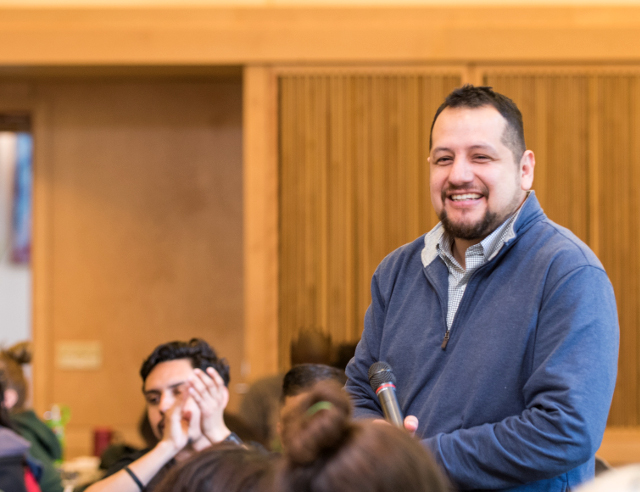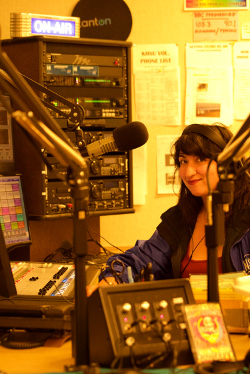
“Everyone was filled with fear, and then around Laytonville, we heard Radio Bilingüe, which helped ease some of their anxiety,” says Paz (‘08, Ethnic Studies, History), now the coordinator of Latinx Center for Academic Excellence at Humboldt State. “Around that time, my friends and I thought, ‘Wouldn’t it be nice if we had something like Radio Bilingüe.’”
Nearly a decade later, that dream is real and on the air.

Teaming up with KHSU, Radio Bilingüe national programs hit local airwaves in August. It can be heard from Eureka to Trinidad on KBAE 95.5 FM, making a vital source of information more accessible to the growing local Latino community, including Humboldt State students.
The move was possible with support from the Humboldt Area Foundation, the California Endowment, the Smullin Foundation, and the James Irvine Foundation, plus resources from Humboldt State University.
Founded in 1976, the nonprofit radio network based in Fresno, California, reaches listeners across the United States, Puerto Rico, and parts of Mexico. Programming is free for affiliates like KBAE.
Radio Bilingüe provides music, plus timely and relevant information on topics such as the Deferred Action for Childhood Arrivals (DACA) program.
“Just the other day, a lawyer on Radio Bilingüe was answering questions about immigration relief programs and dispelling some myths. This type of programming provides clarity,” Paz says. “Without a doubt, Radio Bilingüe is definitely going to increase the quality of life not only for residents but also for Latino students. They won’t feel alone knowing they have a community.”
KHSU General Manager Peter Fretwell believes Radio Bilingüe also empowers a community that many feel has been neglected.
“Everyone knew it was the right thing to do for the community to give underrepresented residents a voice,” he says. “Thanks to a grassroots effort, we can deliver news on issues like health care and immigration—things that are important to Latino residents.”
That grassroots effort began in 2015 when Paz and two colleagues—Spanish teacher Mike Clark and KHSU host Damián Campos—started gathering community support for Radio Bilingüe. The following year, KHSU helped a community coalition led by the Ink People Center for the Arts, launch Radio Bilingüe to KIPE (89.7 FM), a low-powered radio station.
KHSU began streaming Radio Bilingüe online and on digital radio in May. By August, KHSU had the station and the FM frequency it needed to begin broadcasting Radio Bilingüe, which carries some KHSU-produced local Spanish-language programs, as well.
The long-term plan includes incorporating more local programming by HSU’s journalism students and other Spanish-speaking residents of the North Coast, and expanding program reach. Ultimately, Fretwell and others hope to make 95.5 FM an outlet for multi-lingual programs.
For Paz, hearing Radio Bilingüe on local airwaves is not only thrilling but also profoundly meaningful. “This is one way of saying thank you to the Latino community in Humboldt that has given my family and me so much.”
About Radio Bilingüe
Radio Bilingüe was founded as a single nonprofit station in California’s San Joaquin Valley in 1976 by volunteer farmworkers, activists, artists, and teachers as La Voz que Rompío el Silencio — The Voice that Broke the Silence. Radio Bilingüe produces the first—and only—daily national Spanish-language news and public affairs programs in public broadcasting. With its national breadth today, it continues to counter inequities in access to the public airwaves, prizing its role as a pivotal medium for reaching socially, economically, and linguistically marginalized populations.